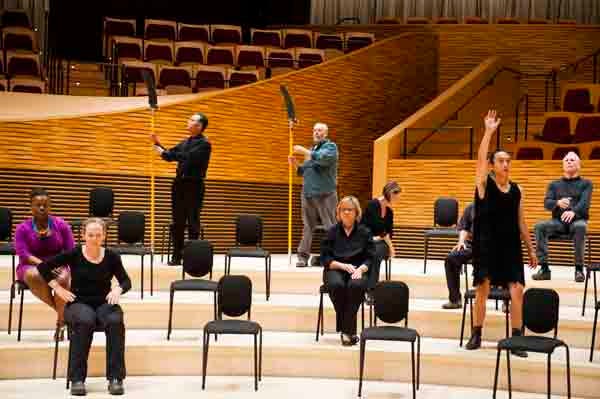|
May 3, 2013
Stanford visiting artist Ann Carlson creates a performance piece made entirely of gestures
Students, faculty and staff participate in a movement-based orchestral work titled 'The Symphonic Body: Stanford.' By Robin Wander

Faculty, staff and students perform gestural portraits based on the motions of their day as they rehearse 'The Symphonic Body: Stanford,' choreographed by visiting artist Ann Carlson, in Bing Concert Hall. (Photo: Toni Gauthier)
Ann Carlson has been animating the Stanford campus, sometimes with silence, sometimes with stillness, for over a year as a visiting artist in dance and performance with the Department of Theater and Performance Studies. Carlson's work mines the ephemeral and the commonplace toward extraordinary results.
Her upcoming project, commissioned by the Stanford Arts Institute, is a movement-based orchestral work, performed for the most part in silence. The Symphonic Body: Stanford will be performed at 8 p.m. May 29 in Bing Concert Hall. Tickets are $10.
This one-time-only performance event is made entirely from gestures. Instead of trained musicians, the 70 participants are Stanford faculty, staff and students – including the entire men's volleyball team. Instead of playing instruments, they will perform gestural portraits based on the motions of their day. These portraits are individual dances, custom made for each person, choreographed from the movements they already do.
Whether pruning a rose bush, clicking a mouse, lecturing students or discussing research, the participants are working with these gestures as "found objects" and, under one-on-one direction by Carlson, transforming them into performance.
Embrace and surrender
"By engaging with this choreographic performance practice, members of the Stanford community come together in concert to expand, renew and re-experience the artistry embedded in the everyday," said Carlson.
"The Symphonic Body: Stanford builds on a practice I have been engaged with for more than 20 years," she said.
"I make performance works with people gathered together by a common profession or activity or shared passion. Lawyers, security officers, nuns, fly fishermen, custodians, a farmer and her dairy cows, physicians, poker players, cowboys, development directors, among others, have performed in this series of works."
Carlson thinks of this work as a dialogue between embrace and surrender. In the case of The Symphonic Body, she explains that whether it's the performance studies professor or the groundskeeper, each embraces his or her identity as the context of the performance. In her artist statement, Carlson writes:
This (self) embracing draws metaphor and meaning from the surroundings of the everyday. But during the making of the performance the embrace gives way to a surrender, there is a letting go of the individual identity into an experience of being part of something larger than the self. Symphonic Body is a social sculpture.
The particular choreographed gestures themselves become part of a larger movement tapestry within each performer and within the piece as a whole. So, these works, performed by the actual individuals who live with these gestures (as opposed to trained performers taking on the gestures of other people) exist in this tension between embrace and surrender, giving rise to questions about what constitutes humanity and aliveness in a given moment.
An unconventional artist
Carlson is a choreographer, performer and conceptual artist whose award-winning works have delved into the nature of vernacular cultures by adapting and choreographing everyday gestures into dances. Carlson's practice takes the form of solo performance, series projects and site-specific works. She makes dances for herself, dancers, non-dancers and even animals.
In March 2012, Carlson staged a performance hike at Stanford's Jasper Ridge Biological Preserve, where actors recreated nine archival photographs, tableau vivant-style, on or near the spot where the original photograph was taken.
Her works have been presented in conventional spaces such as theaters, museums and galleries, as well as unconventional spaces such as walking tours on city streets, rural rivers, passenger trains, empty retail stores, horse arenas and sculpture parks.
Bing Concert Hall brings Carlson back to a more traditional performance stage, but her gesture orchestra is anything but conventional.
-30-
|